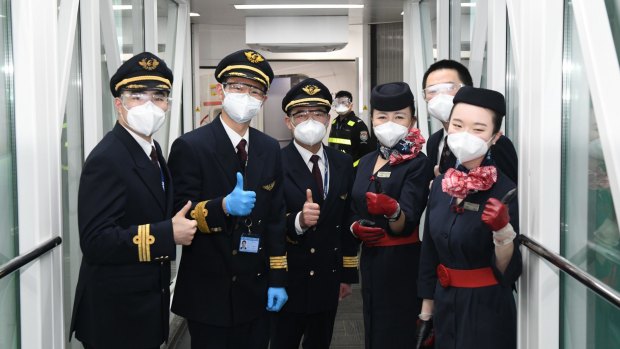This was published 2 years ago
Why China's airlines have disappeared from Australia's skies
By Michael Gebicki

A China Eastern Airlines crew. Prior to the pandemic, more and more Chinese airlines were adding routes to Australia. Credit: Getty Images
Before the pandemic struck there were nine China-based carriers operating flights to Australia. Today there are just two.
Pre-pandemic you could fly non-stop from Sydney or Melbourne to Shanghai, Beijing and 10 other cities in China. Today even those cities are a one-stop flight, and the price of a return ticket to either has blown out threefold.
Even measured against the shock that the pandemic has delivered to the world's aviation industry, the decline in flights operated by China-based airlines between China and Australia has been magnified several times over, although that decline is also a consequence of another kind of virus that has inserted itself into China-Australia relations.
What happened?
At the beginning of 2017 there were seven China-based carriers operating flights to Australia. Fired by a burgeoning middle class eager to see the world and an education market on steroids, it was boom time for trade and tourism between China and Australia.
Just a few months earlier the Australian Government had announced its intention to offer fast-track visa processing to Chinese tourists, and confirmed the introduction of 10-year, multiple entry visas for eligible Chinese visitors. That was part of an open-skies deal brokered between China and Australia, removing all capacity restrictions on their respective airlines.
Within a short time two more China-based airlines had begun flights to Australia, offering non-stop connections to destinations as exotic as Hangzhou on the East China Sea, Kunming, the Fujian port city of Xiamen and, on the Yellow Sea, the port of Qingdao. They also offered cheap onward fares for Australians looking to fly from Australia to Europe or North America, whether it was economy or busines class.
When did it all go wrong?
At the beginning of February 2020, faced with the rapid spread of the coronavirus, Prime Minister Scott Morrison banned arrivals from mainland China. Ever since they began operating on the China-Australia route, seats aboard the China-based carriers had been filled predominantly by Chinese nationals, and the pandemic and the ban sent their numbers into a tailspin. Banned from travelling overseas without an exemption after March 2020, Australian travellers were unable to take up the slack and fill those empty seats, and the China-based airlines evaporated from our skies like contrails.
In the year ending June 30, 2019, more than 1.4 million Chinese nationals visited Australia, more than any other nationality, contributing a combined total of $12.4 billion to the Australian economy. In the year ended June 2021 that number dropped to 3400, and all but a tiny fraction of that $12.4 billion had disappeared.
The prospects for a revival are slim. In one week at the beginning of January 2022, China recorded fewer than 500 inbound international flights, compared with about 10,000 in the same week in January 2020.
The slowdown is part of a much wider contraction of China's aviation industry. For a while it looked like China's airlines might escape the worst impacts of the pandemic as airlines around the world mothballed significant numbers of their fleets. In China meanwhile, domestic tourism was galloping as international travel was banned, and that meant a bonanza for the domestic aviation industry.
As early as October 2020, China's domestic air travel was trending above that of October 2019. There was a drop-off when China went into lockdown in mid-January 2021 but by March, more passengers were travelling aboard China's domestic air services than in March 2019, the only country in which domestic air travel had rebounded so vigorously.
Much of that impetus has been lost. China has been prepared to take harsh measures in response to spot-fire outbreaks of COVID-19. Witness video footage of workers welding shut apartment building doors in Wuhan in the early stages of the pandemic, imprisoning residents in COVID-19 hot-spots in their homes. Those measures include shutting down domestic airline travel. When COVID-19 cases started rising in the northern summer of 2021, domestic air travel for the month of August fell by more than 50 per cent compared with August 2020.
Even if and when the pandemic is no longer a threat to world travel, China-based airlines will not be rushing back into Australia. China has shown its willingness to weaponise its tourism industry, shutting down visits to countries that displease it. That's what happened to South Korea in 2017 when China banned its travel agencies from selling package tours to the country after Seoul installed a US missile defence system.
Coinciding roughly with the onset of the pandemic, relations between Australia and China have turned frosty. As long as the current state of enmity prevails between us, China's airlines won't return to our skies in anything like their previous numbers, and nor will those Chinese students and tourists.
See also: A two-airline country: Why it's so hard to start a new airline in Australia
See also: China's three biggest airlines take delivery of first Chinese-made airliner
Sign up for the Traveller Deals newsletter
Get exclusive travel deals delivered straight to your inbox. Sign up now.